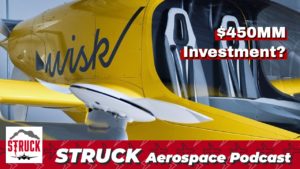In this episode we discussed the GE9X jet engine and its increased power output and status as the largest jet turbine engine in the world. Boeing announced publicly that they thing hydrogen powered commercial airliners will be much more difficult than previously thought, and Allen weighs in on why this is probably correct. Lastly, we touch on some lightning strike news and discuss at length the future of EVTOLs – are they really as viable as many think, and who will win the race to the market (and profitability). Is there enough room for so many companies?
Learn more about Weather Guard StrikeTape segmented lightning diverter strips. Follow the show on YouTube, Twitter, Linkedin and visit us on the web. Have a question we can answer on the show? Email us!
Podcast: Play in new window | Download
Full Transcript: EP29 – The New GE9X Jet Engine, Boeing’s Take on Hydrogen Power & The Future of EVTOL Air Taxis
Welcome back to the struck podcast. On today’s episode, we’ve got a bunch of topics. First. We’re going to talk about Boeing. And their assessment of hydrogen power, which they think it’s going to be a pretty difficult task to get up to speed there by 2035, where it talks about the 737 max and FAA administrator has, um, committed to flying that plane coming up soon.
So we’ll chat a little bit about the implications there. There’s also another hydrogen powered passenger plane from Piper that took its maiden flight and a recent, uh, was struck by lighting in New Zealand. So we’ll chat about that in our engineering segment, we’re going to talk about the GE9X jet turbine engine.
It’s going to be used on the 777X, the triple seven, um, such a big engine, the biggest in the world. So we’re going to talk about that. Also incredibly fuel efficient. And lastly, in our EVTOL segment, we’re going to talk a little bit about the Embraer X concept, but overall, we’re going to chat about the state of the industry in general.
So Allen let’s jump into it. Boeing thinks hydrogen is going to be difficult. Why?
Allen Hall: Because you have to redesign everything. And when, I mean, redesign everything, I mean, redesign everything. You’re going to probably start with a different looking airframe. Uh, so you’re probably talking a blended wing type of design, which NASA was working on for years ago and Boeing was involved with, and some of those and which Airbus is also talking about now go figure.
And every other piece of a fuel system. On that aircraft will have to change. And that, that includes the engines cause the fuel burns hotter. Uh, all the plumbing and all the safety features that go into, uh, making sure a fuel system works properly and doesn’t endanger, the aircraft will have to change and that, and that means plumbing, clamps, brackets, uh, valves, or working at way different colder temperatures.
Uh, you gotta worry about condensation and frost and, and, and Bredell elements and all the things that come along with working with a very cold fuel you’ll have to. Does it redesign the system? So what Boeing is saying is guys industry, do we realize that it’s not as easy as like flicking a switch and we can just basically plumb in hydrogen into this existing architecture because it won’t work and we have to start over.
And starting over on engine development, which is tremendously expensive to fuel system design and structural components and leak detection. And all those things that we do are, have to be start, are starting over. And we don’t have a lot of history with any of those systems and the companies that would make those systems like a Parker.
Uh, you named one of the fuel companies that, you know, Parker being one of the bigger ones, is that how they gotta, they gotta learn how to do that. So every part of the industry, no matter what tier you are in the aviation world, from Boeing being the, you know, the tier one and then narrow the suppliers down to little companies like our company will have to rethink how they do everything.
And that just costs. Billions and billions of dollars and the timeframe just gets thrown out the window. What Airbus was talking about was by 2035 that’s 15 years. I’m not sure if you started today and started putting the billions of dollars. So you could do it in 15 years to the, to the safety level that our passengers and our flying public expects today.
So I think Boeing is, is being a little more realistic about it and saying, yeah, We gotta take this with, you know, we will definitely try to improve the, the, uh, reduce the amount of emissions are coming from aviation. Boeing’s 100% on board with that. So those are bus, so is everybody. But I think what Boeing is trying to say, is there other ways that we can address this, that don’t involve dumping all the knowledge and the safety we’ve already developed over the last 60, 80 years and starting over.
That’s a pretty good take. And I think Boeing’s taken a more staged response to it. Uh, it would be similar to an I’m going to use an analogy here, but as similar to the electric vehicles, where now it seems like, well, Tesla is making all these electric cars and general motors is going to make electric cars.
Everybody’s going to make electric cars, but you gotta remember all the other companies that were making electric cars. That failed from the 1960s and seventies and eighties, till today, there were multiple generations of cars that never made it. And what Boeing is sorta saying is that we don’t have that in aviation.
We all have that sort of build up over time so we can work out the details. That’s on a smaller level, on a smaller scale. We’re just going to go for the winter. Start making equivalent to triple seven airplanes out of hydrogen. That is. Historic history would say that that is not a successful way to go about it.
The best way to go about it is to start off small and single engine aircraft, figure out how to do it there, scale it up, get the architecture figured out, do that sort of development work, which is going to probably take 20 years or more, and then get out to that next level. That’s why hydrogen is going to be a struggle for aviation, I think is that who’s kind of, who’s going to write the check for that.
I don’t know.
Dan: Yeah. The incrementalization is, seems like that’s the key. Cause like you said, I mean, I mean, even an aircraft. I mean, to get here with jet fuel, you know, been using that for what, 70 years. And, uh, there’s been a lot of learning over that time. And then, like you said, to throw it all out, just on the biggest scale at the commercial airline or level, that seems like you said, I mean, it’s like a bath.
I mean, how many parts are in a commercial airliner when you’re talking about every one of them, every one of them having to be newly certified for hydrogen that’s. Seems terrifying. Yeah, that’s crazy.
Allen Hall: Yeah, it is. And when Airbus took on the challenge, I thought that was really aggressive. And, and okay. We know we’re all up for a good engineering discussion and fight, and I think you challenge engineers with a goal of I’m going to try to get to it.
But that challenge comes with a cost and how much, how many bodies and how much time we’re going to have to devote to this, to get to something that’s even remotely as safe or liable as what we have today. 30 feet, 30 years, 40 years track records would say, that’s going to be that kind of timeframe.
We’re not going to do it pretty quickly.
Dan: Gotcha. Well, speaking of which the, uh, the Piper M-Class aircraft made its maiden flight recently, this is a hydrogen fuel cell plane. And, uh, I mean, is this the incrementalization that you’ve talked about? I mean, is this. Basically the start of all that.
Allen Hall: Yes, because they’ve, they’ve had a Piper, Malibu is a concert.
Piper is a turbo prop airplane. So it’s got to go to this longer snows on the thing. And what they’ve done is first, they. Took out the, uh, G fuel system and taken out all the, all the stuff that involves, uh, the standard turboprop engine put in batteries, put in an electric motor, and then they had this sort of like this empty space behind electric motor up in the nose.
Well, so they’d been flying around with the electric motor for awhile. No sweat. What they have done now is they’ve taken an, basically a hydrogen fuel cell. And just drop that into the space where the turbo prop engine was. So they have hydrogen fuel tanks on there and assist them to convert the hydrogen and the oxygen from the atmosphere into electricity, which then powers the rest of the system.
So that is an incremental step to do it. What we haven’t heard yet is what the weight of that the system is the cost of that system. Is, and is it scalable and what does it look like up scalable? Because that’s the only thing that matters. If you can do it on a Piper Malibu, that’s, that’s great. And I think it’s a big step forward, honestly, for the engineering side.
But when we’re talking about demanding that Airbus produces hydrogen airplanes, there’s a huge leap from. A single engine, aircraft, electric aircraft to an Airbus, a three 20 type airplane. Yeah. So he can just see the progression in your head where all right, we get this hydrogen thing working. We’re going to try to reduce its weight and reduces costs and make it more efficient.
All those things have to happen. First, you go from a single engine turbo prop type airplane to a twin engine to something bigger, like a dash eight or an ATR 42 72. And, or Q 400. And that’s your next level up in terms of turbo prop airplanes, try to get those up and running and then what, what’s your next leap?
Right? I don’t know, because in the way that, that that system is set up, it’s an electric system. And the only way that system works is with the propeller. It doesn’t burn fuel like a jet engine does. So it’s only gonna go so fast. So you’re kind of stuck into the turboprop world. How scalable it is. It has, has really no impact on the sort of the seven 37 Airbus say three 20.
Cause it’s still things burn fuel. And this thing is a turboprop. So it’s not going to be relatable and sense of the way they’re going to do things, but it can be that sort of that first step. It can be. Yeah.
Dan: Yeah. It says it only goes up to 87 miles per hour. So yeah, definitely no different movement, different class than commercial travel for sure.
Yeah. So let’s talk about the seven 37. So a FAA administrator has completed the joint operations or is completing the joint operations evaluation board, um, like a standards, the, the training, and then he is going to fly this plane. Um, this FAA administrator, Steve Dixon. So what does this mean for the seven 37 max?
This is standard procedure that happens and getting a plane back or is this kind of. A little bit abnormal,
Allen Hall: really abnormal the FAA administrator. Well, one he’s a pilot, so he can fly. He can fly this airplane, but, uh, it’s mostly feels like a confidence factor. Like if the FAA administrators willing to fly in it, then why are you not willing to certify IASA transport Canada?
Uh that’s. That’s. What that’s trying to say is just as a public relations thing, when it comes down to it who flies the airplane during the flight test, doesn’t really matter what everybody on the engineering side and the certification size kind of say is, does it meet their, the regulations? Does it meet the intent of the regulations?
Uh, can you show me that it has systems in place to prevent what has happened previously and until that’s done and everybody’s comfortable with that? Then the seven 37 is going nowhere. Now it seems like they are imposing additional checks and other things besides the mods that be made. And one of them is a biscuit angle of attack, sensor check, which makes sense to me since that seems to be a rural problem child.
And, uh, some also minimum equipment lists. What things have to you work on the airplane before you can. Take off. Right? So not having a functioning AOA would be, was like one of those things you couldn’t fly with. So there’s a lot going on behind the scenes that we’re not seeing. Clearly now the COVID-19 yeah.
Sort of get buying Boeing some time, but they want to get that thing the seven 37 certified as fast as they can. And if it takes CFA administrator flying in it to, to get over that threshold and to build confidence, then Boeing is going to be 100% for it. And just going to go off and do it. I, I looked I’m really looking for.
So I’m looking for, by the end of this year, that 737 is done. They’re making a Mazda, the airplanes that are exist on the ground, and they’re gonna start making some deliveries. That’s where they have got to go to get moving again.
Dan: Gotcha. So air New Zealand and a three 20 on flight NZ, 696, uh, was struck by lightning and there was a travel editor on board and he said it happened really fast.
Most passengers probably didn’t even notice it, you know, be with their noise, canceling headphones or just happily, you know, oblivious. Um, what do we need to know about the, the being struck? And is this just a pretty run of the mill? Just reporting because it’s interesting or is there anything to know?
Allen Hall: Oh, I think it’s interesting that Australia and New Zealand.
Publish lightening strikes the aircraft relatively frequently and you know that they’re happening in other places around the world, but you don’t see. News articles about them. So I don’t know if it’s just, things are slow in the newsrooms and New
Zealand
Dan: and Australia or news cycle.
Allen Hall: I yeah. Or, or is it just that the flying public is more aware of it is more concerned about it, or lightning strikes are more of a hazard in the country.
So everybody’s just a little more, um, uh, interested in what happens there. But every time you read an article from, uh, Australia, New Zealand, it says there’s some. Airline representative that says essentially this, Hey, uh, are planes designed to take this like two strikes, two aircraft or routine? We did, uh, the.
Inspection that’s required and we’re going to put the aircraft back in service. I see what they all say. So they have a canned response for the spokesperson on these lightning strikes. I just think it’s interesting. And I wish that we had a little more lightning strike type reporting in the United States because you know, aircraft getting struck in the United States and in Europe all the time, but you just don’t really read about it unless there’s some significant level of damage, because I think the flying public doesn’t realize that if you fly regularly, that you.
Probably have been in an aircraft has been struck. And I, Dan you’re right about people not noticing that they’ve been struck by lightning because in most cases it’s not very loud and it may be somewhat of a flasher, but if you’re not paying attention to it, you may have missed. And so well having somebody on board saying most people didn’t even notice it.
Is right. I think that’s right. So probably a lot of people that have been an aircraft been struck by lightning don’t even know it don’t even know it
Dan: right. In our engineering segment today, we have got an engine to talk about. So the GE nine X is what they’re touting as the world’s next great engine. And this thing is enormous. It doesn’t seem as deep as typical jet engines, but it says wide as a seven 37 body. So as wide as the entire cabin, which is crazy to think about 134 inches in diameter for the fans.
Um, and, uh, it looks like GEs already. They’ve got orders for 600 of these. So Alan, what plane is this going to be on? And who’s buying these and why are they upgrading? And. Why why the big deal behind this new engine,
Allen Hall: the engine is designed at least for now, for the, the Boeing triple seven X, which is their composite wing advanced triple seven.
So it’s the newest triple seven, which is flight test program has been kind of shelved temporarily, but. Uh, GE designed very efficient engine for that aircraft. And every generation of engine is more efficient than the previous generation. And you go, well, does that, how am I, can you drive down that efficiency chain?
Well, we’re finding out now that we can really drive that efficiency chain and reduce emissions out of these engines by making the fans larger. So you, you’ve got a hot section in the middle, which is the jet engine part, and then you have this enormous fan on the outside. And when you look at the engine, Uh, it looks stubby short, uh, because the fan is so large relative to the length of the engine.
So it actually looks it’s proportion. It’s not right. Uh, so if you ever remember back in the day, seventies on the original seven 37, the engines were essentially all jet engine, all hot, and it was like a long cylinder. And now it looks like this. Like a Frisbee on, on one end, what the answer looks like. Uh, but GE has been doing amazing things with aerodynamics on the fans and the fan blades and also additive technology.
To improve the, the efficiency and the burning of fuel in the engine so that they, they re reduce emissions, increased performance. I think Dan and he checked me if I’m wrong, but I think that engine has like 130,000 pounds of thrust. So isn’t that the largest thrust producing engine? I think that, I think that’s right.
I know it’s close to the engine for the, for the, for the seven, eight, seven was close. So this, I think this is, it’s a bigger engine clearly. And. I saw this engine, uh, when we were down in Tucson, Arizona, they were installing the engine on the seven 47 platform to flight test it. So it was next to the, uh, air museum down at Tucson’s and like on the next hanger over.
So you’re looking at the back end of the seven 47, you say seven 47 engine. Seven 47 engine gigantic huge engine seven 47 engine. And it just dwarf the seven 47 inches. It was just, it’s hard to describe that inch in diameter is it’s enormous. It’s enormous. Uh, so, you know, I always think the triple seven is a, is a large aircraft to begin with and it’s getting bigger, right?
Cause it’s going to have the fold up wing tips coming on with this new version, but the, the. When you look at the, when you were looking at that engine that day, I’m looking through the fence line. You’re like, wow. Everything about that engine has a lot of engineering involved with it from the fan blade shapes the shape.
You could just tell that they had spent oodles and oodles amount of engineering time squeezing out every last. Possible ounce of efficiency. And if you compare that to an engine from the 19 jet engine, from the 1960s or seventies, and not even close to one another in terms of how they operate in, in, in today’s world.
So, uh, Uh, when the seven triple seven X gets up and going again, we’re gonna get a better feel for how that engine performs. But, um, I’m really interested to see, like we talked about efficiency on other things. What does the next generation look like if this, if we’ve gone this far? Because I can’t. So if, if the fan diameter is a seven 37 fuselage, What’s the next one.
Dan: Yeah.
Allen Hall: It can only gets bigger. Right. And only gets bigger. And which means that you gotta Jack the airplane off the ground higher. So you can stick this engine on the, underneath the wing. So it doesn’t scrape the right away because it’s the fan size. If you see the pictures of the triple sub of that GE NYNEX engine on the seven 47 platform, you go, wow.
An engine issue.
Dan: Yeah. Well, I mean, what are they going to have to start? I mean, are they can have the cert engineering, the wings. Differently to accommodate bigger engine sizes. I mean, did they already putting more bracing in STEM or, or they already are ready to handle a ton of weight as it is?
Allen Hall: That’s a really good question.
Well, one, because you have to generate so much thrush gotta to be a handle that thrust load. Uh, and then there’s some issues about if you’re kind of flying sideways. If you’re not quite flying with the aircraft and with, against the wind, you’ve got this sort of side load on the engine. So you’ve got some twisting that goes on there and you usually gotta compare to carry those loads.
Um, I think, yeah, you have all those problems, right? You have the throws from the silo problem, the vibration problem, which is a big one. If you lost a, a, an inlet fan blade is going to call windmill and it’s going to shake itself and it’s got all this icing testing and you have to do, um, so it does change the way you design the wing and the triple seven X is a composite wing, so they can put a lot of, of structure up in there to hold this thing.
Uh, I wonder what the cause when you raised that point, because I wonder what they did with the seven 47 test bed. If they ended up doing a lot of structural changes to that aircraft to support the weight of that new engine or the NYNEX engine before they did it. So they made us spend a lot of time and you’re right.
You put a bunch of heavier engine on it. It’s a lot more thrust. You got to. The, the wings will be able to carry it. It does add to the complexity of the system. Sure. It does.
Dan: Yeah, of course. They said it, it doesn’t, it doesn’t have to be heavier when the engines get bigger. So they said the G at nine X is actually not that much heavier than it is definitely higher than the GE 90, but you know, they use composites and a bunch of carbon fiber, three D printed parts.
And so they went to a lot of lengths to, to keep or to keep. To keep weight down when that, where they could. Yeah. Um, can you speak a little bit to some of these, uh, these materials? So they’re talking about ceramic tricks, uh, composites that can still hold their, I guess, their strength and their hardness up to 2,400 degrees Fahrenheit.
So it sound, it sounds like heat is a really major limitation and the way they design and build these.
Allen Hall: You want to burn hotter to have less emissions. He wanted to make sure you burn every piece of fuel that comes through it. And so, and then get as much thrust as you can out of that hot section. So that means you’re probably gonna run a hotter.
And when you do that, all the components, all the fan blades, all the little, little pieces inside that engine have to work at higher temperatures. And what that means is you’ve gone from, you’re leaving the metal world to getting into the, to the ceramic world. And that’s not an easy thing to do. And so they’re making additive parts in ceramic because of the temperatures.
So as I was saying before, what what’s the next generation look like? What comes after ceramics?
Dan: Yeah, I don’t know.
Allen Hall: Right? Cause you’re. All of a sudden you’re sort of at that top level of materials there isn’t, at least to my knowledge there, isn’t a next stage besides just refining what you’ve already done.
Maybe that’s the plan, but you’re sort of there right now. It’s, what’s the, what’s the curve, uh, for, uh, like the computer chip industry where it grows exponentially.
Dan: Yeah. I can’t think of the name for that effect, but you’re right. Like, I mean, just like with any of that, even with human performance, like, you know, sprinters in the Olympics, like.
It w no, one’s beating anyone by more than, you know, a couple of hundreds of a second now. So it seems like every technology is starting to get to that point. So
Allen Hall: it starts to flatten out, right? You got this, uh, rapid ascent as you learn how to do this thing, and then it tapers off. And so you starting to feel like on some of these engines that we’re starting to get into that taper off point.
So what’s next and it’s the watch next. I keep waiting to hear and I haven’t seen it yet. And maybe it’s the, you know, the sort of the scramjet, um, hi, you know, mock one plus engines, whatever those things are gonna look like, who knows, but we’re going along for the ride.
All
Dan: right. In our final segment here today. We always would chat a lot about the Evie tol segment and the electric aircraft segments. So, uh, today the Embraer X, E V tol concepts, you know, this is just a concept, so there’s no actual, um, prototype yet, but yeah, you know, they’re just the next company to sort of enter this space and have their own design.
This one is. Pretty unique. It’s got some, it looks like ducted fans. It’s also got a number of, uh, um, you know, rotors up top. So all just variations on this overall, you know, design game, looking at this future market. But. Alan, you said you had some thoughts as far as Tesla battery day, and they had some, you know, Elon Musk shared some interesting ideas as far as how they’re going to bring their Tesla electric cars down to commercial viability, as far as price and ease of manufacturing and just.
Trying to get it out, out the door simply and build their factories and all the stuff around it. So what, what’s your take on the market as it continues to get more and more crowded and these designs continue to be complex. Um, what do you get? What have you got for us?
Allen Hall: Well, the. Big picture is I think at least early on, it’s not, you’re not going to sell these aircraft in the thousands per year.
You’re going to sell them in the dozens per year, probably because of the price point. And unless you can drive down the cost of the aircraft and that means systems and structures combined and. And greatly reduce the complexity so you can lower the cost and reduce the amount of labor that’s involved in making these things and labor tooling, raw materials, all the, all the things it takes to do it, then what are we doing?
Because what you’re going to end up with is what we always end up with is a very expensive, limited, narrow market, a product. And. If, if the concept is we’re going to have a Mo mobile era mobile society, then you’re going to need, at least the United States, you’ve got 300 million people, 300, 3 million plus, and, you know, Billions here, billions there.
How, how are you conceptually gonna think that you’re gonna be able to serve that marketplace if every aircraft costs $150,200,000, there’s just no way you can satisfy that. It’s like you’re in the sports car market. That’s a different, right. So the sports cart market, when you buy up. Ferrari or whatever.
And you’ve got some person in there put you builds the engine himself. Right? And so the, the cost of the labor is extremely high on the cost of parts, extremely high. You’re like, okay, but that’s a Ferrari. But if you’re trying to get to, everybody can own this thing and you got to drive it down to the price of a car.
Now think about that. We can’t make cars for the price of a car right now. How are you going to make an aircraft, the price of a car, or you have to really fundamentally rethink the way you do this. And I haven’t seen, I’ve seen a lot of different designs pop out. They’ll look cool. They got the lights, they got the rotating blades.
Oh, that’s great. But where the technology is going to come from, as somebody, some company has got to figure out how to lower this thing down in terms of price to manufacture, which means you need to be rethinking about what material is used to manufacture these aircraft out of. And what systems are you going to put in them that you need just to fly a thing.
And we’re not there yet. We’re just not there yet. We see a lot of cool designs, but here’s, here’s what they all say. We’re going to have, I don’t know, eight, eight electric motors. You’re going to have lithium ion batteries. Bingo, bingo. Both those things are expensive. It’s going to be all carbon fiber.
What carbon fiber is expensive because there’s a huge demand for carbon fiber. So the raw material is expensive. You got to be able tooling. Which is expensive. You’re probably going to hand lay this thing up. So you have a bunch of, of, of laborers that are skilled at composites, which is not cheap handling up every part you’re going to have autoclave, maybe that’s expensive.
So every part of the RME part of the build and putting all the systems in is expensive. Every part of the build is just huge money. There’s no way to do that and satisfy what you think you’re going to, what the demand is, what you think the demand is. So the design and the, and satisfying the demand or the marketplace don’t align yet.
And so it doesn’t really make any difference what the designs look like. So until we fix the way we build the airplanes or rethink the way we build airplanes, you can’t do it. You see that too, because must toss about that all the time. Cars.
Dan: Yeah. So it’s not clear what, you know, who knows where we ended up going with these vehicles.
Like maybe, you know, someday you can own one, right? Like you could have on waiting on top of your New York city building. Like that’s where your, your little aircraft is parked, but it seems like. The market, most of these companies are going after is the taxi service, right? So there’s going to be hubs all over the city and they’ll take you, you know, 60 miles or 40 miles or 30 miles.
Um, but it seems like the same challenges are there. So even though, so, you know, most of these companies, you’re probably not looking to outfit, you know, a hundred million Americans with their own flying vehicle. Um, How many of these ports could there be what’s the carrying capacity for the amount of these helicopters?
You know, even if you have one size of a parking garage, what can you have six of them on there? I mean, they all need space, right? They right there, uh, they’re just kind of wide a lot of the designs, even though they’re not super big. Uh, but then, okay, so now we have 10 companies. And you’re all fighting to have one of your vehicles or all of your vehicles in New York, city’s hubs or this hub.
Right? And so there’s 10 companies, 20 companies all competing for a finite amount of these EVT that can be in this taxi market. So then if you’re a company and you’ve churned out a thousand of these, you only sell 200 of them. I mean, you’re done. And like you said, if are you going to make the tooling and spend all this money to maybe only sell 500 of them in the U S or a thousand or 2000?
I mean, It just doesn’t seem like there’s room for all these different companies in the market. They’re all just going to fight for finite a definite amount of finite space. So. There’s definitely. Yeah, there’s definitely, it’s going to be really interesting to see how that shakes out because it just doesn’t seem like there’s enough room for all these players.
Allen Hall: I don’t think so until you lower your cost down where you can make a profit, a significant profit per each one. So if you’re going to use round numbers here, if you’re going to sell it for a hundred thousand dollars, that means you’re going to make it for less than 50, and that’s just to keep the doors open.
So ideally you want to make it for 30, 20, right? Um, And making a $20,000, anything is difficult and that’s why the Tesla cars are so expensive in my opinion, is that they have costs and the infrastructure that they haven’t gotten rid of yet. And that’s why what’s the latest version. The, those expensive version is that the X is the expensive version of the Y.
Dan: Yeah.
Allen Hall: I think you can make yourself a hundred thousand dollar car there. Fast.
Dan: Well, and I mean, do you, do you see like, these companies potentially, like, does Uber have to purchase an aircraft company where then they can say, okay, like we’re going to lose money on the crafts, but we know we’re going to be essentially the airline.
Like we’re going to make it back on the subscription model and the ticket fees on all that stuff. I mean, is that how it’s going to be to survive? And if that’s the case, it still comes back to my sort of idea, which is that. How many companies can do that. Right? I mean, if Uber, if Uber is big enough or some other, company’s big enough to produce the aircraft themselves, okay.
Now they own the helipads. They own the, you know, they own pretty much the infrastructure. How many companies like can stay viable if they are doing that? It’s just, it seems like if you don’t make it, if you’re not first, you’re just done. Like there’s no second, third, fourth place. It’s like Ricky, Bobby from that, you know, tell back at nights, if you’re not first you’re last.
So I don’t know
Allen Hall: true though, but mean being the first one to the marketplace and having the certain standard for everybody else is huge because you, the first one to marketplace is defined. Some marketplace would typically own between 60 and 75% of it, no matter who else comes into that marketplace. But the problem is no one’s really defined the marketplace.
Quite yet. I know they’re talking about it, but why, why haven’t I Kobe stolen a kink and everything, but why have we haven’t we really seen manufacturing efforts going on. We see prototypes, we see a limited flight test programs with automated flight test programs. There’s nobody in it. Where’s the production line.
Where’s the tooling. Where’s the concept. How are you going to keep the cost out of this thing? Where’s all that detail because that’s the thing that matters because every other aircraft company has failed because of that. And the same thing for the airlines too. There’s very few airlines that actually really make money.
Uh, and you can name them. Uh, Ryan air Southwest. And what they’ve done is they just have a cost structure where they driven down their costs and can offer, uh, a more desirable product and they increase their payload. Right. The number of people fly them. I’m not sure to American airlines or United airlines is profitable, particularly to say they’re not, but there is that model even profitable 10 years from now.
There’s a big discussion about that. So if you think you’re going to create this airline sort of Uber in the sky, think twice because the companies that do it today, very few of them make enough money to stay.
Dan: Yeah. W w when we chatted about that before, which, you know, they said like, Hey, if we’re talking about flying a rooftop to rooftop to drop your kids off, On the other side of New York city, it’s probably just not gonna make sense.
It’s not going to take less time. You’re gonna have to go get in the thing, you know, like, you know, you’d be better off just getting in a cab, even in a luxury, you know, have a, have a driver or whatever. Uh, so again, like they have to, like you said, define that. What is their market. And then is it, you know, shuttles from Philadelphia to New York?
You know, is it from, uh, New York to Boston? Is it, can it go there and they go that far? Or is it just the 60, 70, a hundred miles at long Island in New York city? And if so, how many aircraft, you know, can, can support that route? Like how many do they need? Eight, six, 1230. I mean, it’s not tens of thousands, you know?
Um, wouldn’t think so. So how. Back to your original point, which is how do you make the incredible investment, the tooling, the labor, the technology makes sense.
Allen Hall: How do you make a $20,000 aircraft out the door? That’s what you need to be thinking about. And as of yet, I haven’t seen it.
Dan: All right. Well, that’ll do it for today’s episode of struck.
If you’re new to the show. Thank you so much for listening. And please leave a review and subscribe on iTunes, Spotify, or wherever you listen to podcasts. Check out the weather guard, lightening tech YouTube channel for video episodes, full interviews and short clips from the show. And follow us on LinkedIn, Twitter, Instagram, and Facebook.
Our handle is at WG lightning tune in next Tuesday for another great episode on aviation, aerospace engineering and lightening protection.












